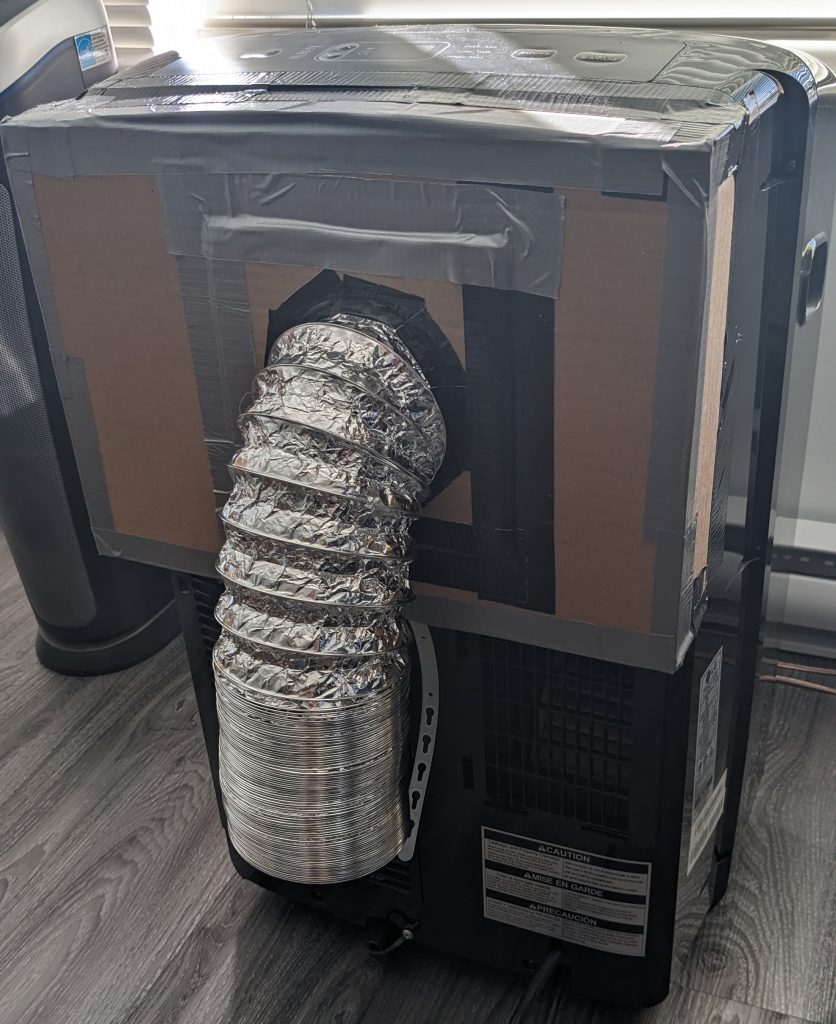
In a recent post, I detailed my attempts to turn my single-hose portable A/C unit into a dual-hose one. I have completed my first-pass attempt at the conversion. If you look at the picture above, you can see the results.
The whole thing was made from recycled cardboard, duct tape, and a $16 flexible aluminum dryer hose I purchase from Amazon. This isn’t really relevant to the story but doesn’t the aluminum hose look like a giant, flaccid metal penis? Uh no? Just me?
Anyways, I finished the assembly in the late afternoon on Saturday and it was sufficiently hot enough on that day to test it out. The first step was to get everything into place again. You don’t see it in the above photo, but the original hose that came with the A/C needed to be attached again. You can see the attachment point is the smaller vent below and to the right of the aluminum hose.
I then had to move the A/C back into my bedroom from the staging area in my living room. I then connected the hoses to the vinyl cover I have that seals off my sliding door opening from the outside. This cover had two distinct openings, so it was designed for dual-hose systems. I place each end of the hoses into their respective vents to the outside.
With some trepidation, I turned the thing on. My initial fear was that I had not sealed the intake vent off properly and some of the air was still being sucked in from the inside of the bedroom. The whole thing is sealed by duct tape, from the edges of the cardboard, where cardboard meets the A/C, to where the hose meets the cardboard. At first glance, it appeared that nothing was leaking.
I could feel cool air blasting from the A/C, so it all seemed ok. I ran outside onto my balcony so I could informally measure how much air was being sucked in through the aluminum hose. I put my hand up to the opening of the hose and I could feel a very significant amount of air being sucked in. It was working! Instead of drawing in outside air into the rest of my apartment, the air was now being drawn in throw this hose, cooled, and then blown into my bedroom.
The real test was to see if my living room was going to get hot after several minutes of running my A/C. In the past, I’ve seen my living room increase in temperature up to four degrees Celsius, in as little as ten minutes of having my A/C. I saw the baseline temperature of my living room was 26 degrees when the A/C was turned on. I waited ten minutes and while my bedroom got cooler, the living room stayed at 26 degrees.
I think I can call this conversion a preliminary success. There are, however, a few caveats I need to point out. First, I noticed there is a secondary vent that I forgot to seal up that is actually another intake vent as well. I discovered this a bit too late. It doesn’t seem to a primary vent because it doesn’t have a filter on it like the primary one does and it doesn’t seem to suck in enough air (or change the pressure enough) to cause the rest of my apartment to get hotter. I suppose I can make a secondary shroud and then make it meet up with the first one, punch a hole in one of the walls and then seal them all up. This would then ensure there is no intake vent at all exposed to the bedroom air. Based on my initial observations though, I’m not sure this is needed.
Second, I noticed the A/C’s thermometer was not detecting the air getting cooler, even though you could definitely feel the air in my bedroom getting cooler and also another thermometer in my room was showing a drop in temperature. I am theorizing that the A/C determines the temperature of the room by sensing how hot the air coming in is. This makes sense, because the original design of the A/C has it sucking in the air around it, which is the air it’s cooling. So if it’s sucking in air and that air is 20 degrees Celsius, the A/C then thinks it must 20 degrees Celsius in the room the A/C is sitting in. I’ve changed this now. The air it’s sucking in is the outside air and that air will always be hotter than the air around the A/C, but now it has no way to measure that temperature. In my test, the A/C was thinking it was 28 degrees the entire time it was running. That must have been the outside air temperature. The consequence of this change is that I can no longer rely on the A/C to turn itself off once it reaches its target temperature. It will keep running even if my bedroom is much colder than it needs to be. Of course, I can just stop it whenever I feel it’s cool enough but now I also need to turn it back on when it gets too hot. Is the loss of this automation worth it? I say yes, it’s a good enough trade off for not having an oven in the rest of my apartment.
Third, I have no idea if I’ve affected the efficiency in any way. I’d like to think I haven’t and that it all balances out in the end but I have no clue. Is my A/C working harder to cool the room? I can’t be sure.
Anyways, I just wanted people out there to know, it is possible to convert your single-hose A/C unit to a dual-hose one. It just requires an extra dryer hose, cardboard, and some duct tape. It can work but be aware of some of the caveats.